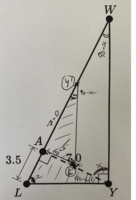Geometry High school level Help
- Thread starter AAA
- Start date
D
Deleted member 4993
Guest
Yes - if you want to - that will give you the length of LY.Hi Guys,
I need help with this. Should I use the Pythagorean theorem for this problem?
Then use "similar triangles" to calculate the length of LW.
HallsofIvy
Elite Member
- Joined
- Jan 27, 2012
- Messages
- 7,763
As you were told, triangle WLY and triangle YLA are similar triangles. Specifically the have angle L in common and each have a right angle. Therefore the third angles are the same. So theIr sides are in the same proportion.
We do need the Pythagorean theorem because the side whose length we are asked to find, LW, the hypotenuse of triangle WLY, corresponds to LY, the hypotenuse of YLA. We have LYLW=AYLY.
You need the Pythagorean theorem to find LY,
We do need the Pythagorean theorem because the side whose length we are asked to find, LW, the hypotenuse of triangle WLY, corresponds to LY, the hypotenuse of YLA. We have LYLW=AYLY.
You need the Pythagorean theorem to find LY,
HallsofIvy said:We have LYLW=AYLY.
Please check that proportion against that diagram.
D
Deleted member 4993
Guest
Can you list the similar triangles?Can you explain to me the steps I should take?
I'll start off:
triangle LAY is similar to LWY
triangle YAW is similar to LWY
Continue...
AAA
Junior Member
- Joined
- Nov 29, 2020
- Messages
- 63
How do I know which triangles are similar? Thanks btw for the explanation.
Let the angle at L be size 'x'
Fill in the sizes of the other angles.
(Look for similar triangles).
Swing triangle ALY onto triangle AWY.
...
Work out AW.
Hence, work out LW.
View attachment 26662
Triangles are similar when the three angles in one are the same as the three angles in the other (i.e. the set of three angles in one is the same as the set of three angles in the other).
That's why I said label the angle down at L, as xº. Then fill in all the others. So you are looking for triangles which contain this set of angles:
xº, 90º, and (90-x)º
One triangle is a 'scaled up' version of the other.
That's why I said label the angle down at L, as xº. Then fill in all the others. So you are looking for triangles which contain this set of angles:
xº, 90º, and (90-x)º
One triangle is a 'scaled up' version of the other.
pka
Elite Member
- Joined
- Jan 29, 2005
- Messages
- 11,988
In any right triangle the length of the altitude onto the hypotenuse is a mean proportional between the parts( proven with similar triangles).I need help with this. Should I use the Pythagorean theorem for this problem?
So YALA=AWYA. From which LW=LA+AW.
A handy little wrinkle that. I hadn't heard that expressed so.In any right triangle the length of the altitude onto the hypotenuse is a mean proportional between the parts( proven with similar triangles).
So YALA=AWYA. From which LW=LA+AW.
Nice.


